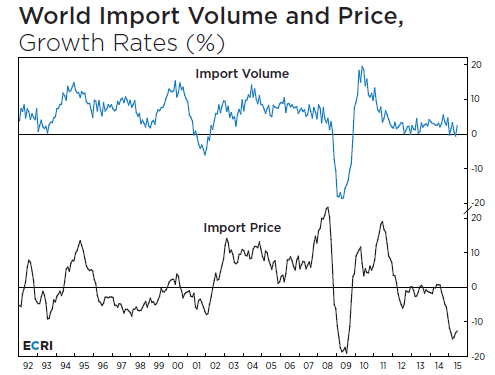By Lakshman Achuthan at ECRI
Six years ago – the last time global import price deflation was this intense – the worst global recession in decades was ending. A key question today is whether recession risks have mounted in the U.S. or any other major economy.

Earlier this year, year-over-year (yoy) world import volume growth dropped to its lowest readings since 2009. Today, it remains in a decisive downturn and near May’s five-and a-half-year low, a far cry from the surge that followed the global recession. Clearly, after years of extraordinary policy stimulus around the globe – aimed at pulling demand forward from the future – world trade growth has collapsed.
Even worse is the nosedive in yoy import price growth, which has been exhibiting double-digit deflation since the beginning of the year (bottom line). Indeed, the only other time on record the world has seen such intense import price deflation was during the global recession.

Certainly, the fall in crude oil prices has played a role more recently. But the world import price level peaked in April 2011, and dropped by 18% over the next four years. So this is not just about the plunge in oil prices over the past year or so.
In fact, in the U.S., yoy growth in import prices excluding petroleum has been in negative territory since the end of last year, and is now near readings not seen since the fall of 2009 (not shown).
The deflationary plunge shown in the chart is mirrored in every region – the U.S., Japan, the Eurozone, Central and Eastern Europe, Emerging Asia, Latin America, and Africa and Middle East – not only for import volume growth, but also for import price growth. Analogous patterns are also evident in the growth rates of the volumes and prices of exports – the flip side of the same coin – for both advanced and emerging markets, as highlighted recently.
Clearly, U.S. import price growth is deeply deflationary – more so than at any time except during the Great Recession. What we see here are deflationary pressures being transmitted through trade worldwide. Thus, for the foreseeable future, import price deflation is likely to keep overall inflation in check around the world.
Policymakers in this century have repeatedly pushed to postpone the payback for previous policy initiatives to boost demand – in the wake of the collapse in the tech bubble, which a housing bubble was designed to supplant, as well as the fiscal stimulus packages, zero interest rates, and QE, all in attempts to push off what is ultimately inevitable in any market-oriented economy, i.e., the next business cycle recession.
Much of what we have written about over the years is now coming to the fore, starting with declining U.S. trend growth, which we first identified seven years ago. But with trend growth in real GDP falling around the world, and deflationary forces intensifying, the only two ways to repay the massive global debt load – generate sufficient real growth, or inflate it away – both seem out of reach. Under the circumstances, as we concluded earlier, “all of these economies are effectively circling the drain,” because “in the fullness of time, all [of them] are likely to face a day of reckoning – and earlier than most expect,” even though “the process may involve a rush to a succession of ‘safe’ assets in the interim.”
Many economists have declared the risk of recession to be extremely low, not realizing that the U.S. economy is in a cyclical slowdown with no end in sight. Though a recession is not yet at hand, such circumstances can eventually take U.S. economic growth within striking distance of recession, especially given the reality of low trend growth.
While we have characterized the 2012-13 period as the worst non-recession in half a century, revised GDP data shows that it may have been an even closer shave. We now know that, in the second half of 2012, U.S. real GDP grew at a scant ¼% a year annual rate, revised down from the previous 1¼ % estimate. In other words, if the economy once again enters a window of vulnerability, it will be very hard to avoid a recession, unless circumstances result in the severe suppression of cyclical volatility.
From our cyclical vantage point, we have long been aware of the truism that recession kills inflation. Therefore, when the next recession arrives, it is more likely to push inflation below zero at a time when the Fed has no obvious policy response. The resulting deflation would be the stuff of policy nightmares.
Source: Double-Digit Imported Deflation | News | News and Events | ECRI


